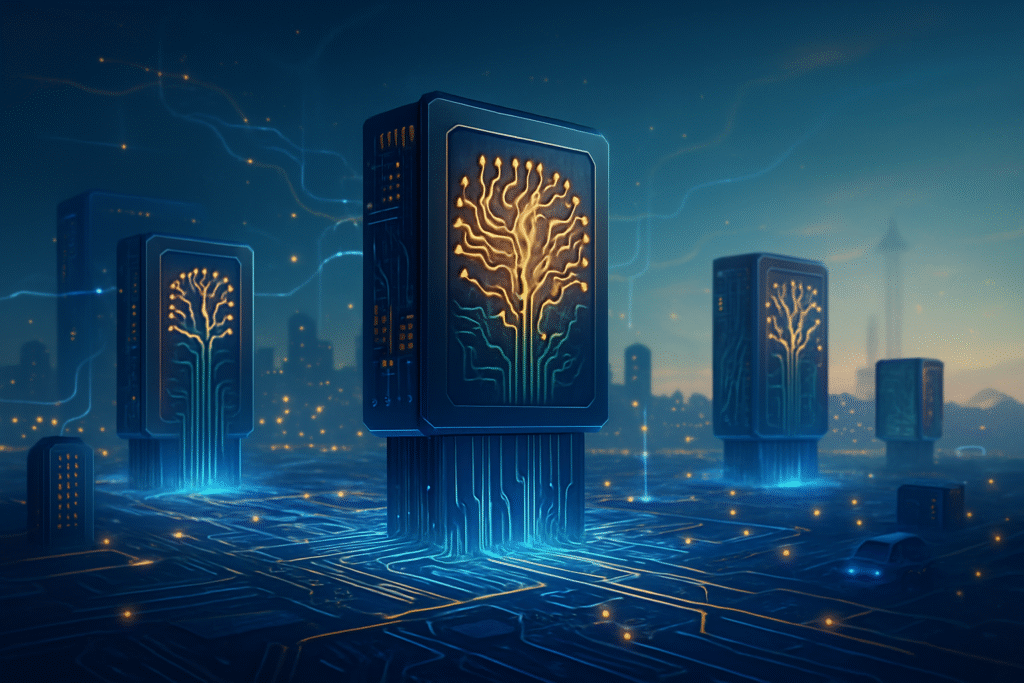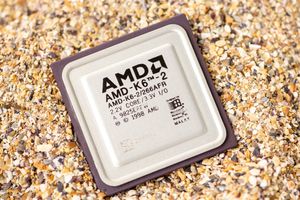
The semiconductor industry, often operating behind the scenes, stands as the undisputed bedrock of modern technological advancement. Its relentless pursuit of miniaturization, efficiency, and computational power has not only enabled the current artificial intelligence (AI) revolution but continues to serve as the fundamental engine driving progress across diverse sectors, from telecommunications and automotive to healthcare and sustainable energy. In an era increasingly defined by intelligent systems, the innovations emanating from semiconductor foundries are not merely incremental improvements; they are foundational shifts that redefine what is possible, powering the sophisticated algorithms and vast data processing capabilities that characterize today's AI landscape.
The immediate significance of semiconductor breakthroughs is profoundly evident in AI's "insatiable appetite" for computational power. Without the continuous evolution of chips—from general-purpose processors to highly specialized AI accelerators—the complex machine learning models and deep neural networks that underpin generative AI, autonomous systems, and advanced analytics would simply not exist. These tiny silicon marvels are the literal "brains" enabling AI to learn, reason, and interact with the world, making every advancement in chip technology a direct catalyst for the next wave of AI innovation.
Engineering the Future: The Technical Marvels Powering AI's Ascent
The relentless march of progress in AI is intrinsically linked to groundbreaking innovations within semiconductor technology. Recent advancements in chip architecture, materials science, and manufacturing processes are pushing the boundaries of what's possible, fundamentally altering the performance, power efficiency, and cost of the hardware that drives artificial intelligence.
Gate-All-Around FET (GAAFET) Transistors represent a pivotal evolution in transistor design, succeeding the FinFET architecture. While FinFETs improved electrostatic control by wrapping the gate around three sides of a fin-shaped channel, GAAFETs take this a step further by completely enclosing the channel on all four sides, typically using nanowire or stacked nanosheet technology. This "gate-all-around" design provides unparalleled control over current flow, drastically minimizing leakage and short-channel effects at advanced nodes (e.g., 3nm and beyond). Companies like Samsung (KRX: 005930) with its MBCFET and Intel (NASDAQ: INTC) with its RibbonFET are leading this transition, promising up to 45% less power consumption and a 16% smaller footprint compared to previous FinFET processes, crucial for denser, more energy-efficient AI processors.
3D Stacking (3D ICs) is revolutionizing chip design by moving beyond traditional 2D layouts. Instead of placing components side-by-side, 3D stacking involves vertically integrating multiple semiconductor dies (chips) and interconnecting them with Through-Silicon Vias (TSVs). This "high-rise" approach dramatically increases compute density, allowing for significantly more processing power within the same physical footprint. Crucially for AI, it shortens interconnect lengths, leading to ultra-fast data transfer, significantly higher memory bandwidth, and reduced latency—addressing the notorious "memory wall" problem. AI accelerators utilizing 3D stacking have demonstrated up to a 50% improvement in performance per watt and can deliver up to 10 times faster AI inference and training, making it indispensable for data centers and edge AI.
Wide-Bandgap (WBG) Materials like Silicon Carbide (SiC) and Gallium Nitride (GaN) are transforming power electronics, a critical but often overlooked component of AI infrastructure. Unlike traditional silicon, these materials boast superior electrical and thermal properties, including wider bandgaps and higher breakdown electric fields. SiC, with its ability to withstand higher voltages and temperatures, is ideal for high-power applications, significantly reducing switching losses and enabling more efficient power conversion in AI data centers and electric vehicles. GaN, excelling in high-frequency operations and offering superior electron mobility, allows for even faster switching speeds and greater power density, making power supplies for AI servers smaller, lighter, and more efficient. Their deployment directly reduces the energy footprint of AI, which is becoming a major concern.
Extreme Ultraviolet (EUV) Lithography is the linchpin enabling the fabrication of these advanced chips. By utilizing an extremely short wavelength of 13.5 nm, EUV allows manufacturers to print incredibly fine patterns on silicon wafers, creating features well below 10 nm. This capability is absolutely essential for manufacturing 7nm, 5nm, 3nm, and upcoming 2nm process nodes, which are the foundation for packing billions of transistors onto a single chip. Without EUV, the semiconductor industry would have hit a physical wall in its quest for continuous miniaturization, directly impeding the exponential growth trajectory of AI's computational capabilities. Leading foundries like Taiwan Semiconductor Manufacturing Company (TSMC) (NYSE: TSM), Samsung (KRX: 005930), and Intel (NASDAQ: INTC) have heavily invested in EUV, recognizing its critical role in sustaining Moore's Law and delivering the raw processing power demanded by sophisticated AI models.
Initial reactions from the AI research community and industry experts are overwhelmingly positive, viewing these innovations as "foundational to the continued advancement of artificial intelligence." Experts emphasize that these technologies are not just making existing AI faster but are enabling entirely new paradigms, such as more energy-efficient neuromorphic computing and advanced edge AI, by providing the necessary hardware muscle.
Reshaping the Tech Landscape: Competitive Dynamics and Market Positioning
The relentless pace of semiconductor innovation is profoundly reshaping the competitive dynamics across the technology industry, creating both immense opportunities and significant challenges for AI companies, tech giants, and startups alike.
NVIDIA (NASDAQ: NVDA), a dominant force in AI GPUs, stands to benefit immensely. Their market leadership in AI accelerators is directly tied to their ability to leverage cutting-edge foundry processes and advanced packaging. The superior performance and energy efficiency enabled by EUV-fabricated chips and 3D stacking directly translate into more powerful and desirable AI solutions, further solidifying NVIDIA's competitive edge and strengthening its CUDA software platform. The company is actively integrating wide-bandgap materials like GaN and SiC into its data center architectures for improved power management.
Intel (NASDAQ: INTC) and Advanced Micro Devices (NASDAQ: AMD) are aggressively pursuing their own strategies. Intel's "IDM 2.0" strategy, focusing on manufacturing leadership, sees it investing heavily in GAAFET (RibbonFET) and advanced packaging (Foveros, EMIB) for its upcoming process nodes (Intel 18A, 14A). This is a direct play to regain market share in the high-performance computing and AI segments. AMD, a fabless semiconductor company, relies on partners like TSMC (NYSE: TSM) for advanced manufacturing. Its EPYC processors with 3D V-Cache and MI300 series AI accelerators demonstrate how it leverages these innovations to deliver competitive performance in AI and data center markets.
Cloud Providers like Amazon (NASDAQ: AMZN) (AWS), Alphabet (NASDAQ: GOOGL) (Google), and Microsoft (NASDAQ: MSFT) are increasingly becoming custom silicon powerhouses. They are designing their own AI chips (e.g., AWS Trainium and Inferentia, Google TPUs, Microsoft Azure Maia) to optimize performance, power efficiency, and cost for their vast data centers and AI services. This vertical integration allows them to tailor hardware precisely to their AI workloads, reducing reliance on external suppliers and gaining a strategic advantage in the fiercely competitive cloud AI market. The adoption of SiC and GaN in their data center power delivery systems is also critical for managing the escalating energy demands of AI.
For semiconductor foundries like TSMC (NYSE: TSM) and Samsung (KRX: 005930), and increasingly Intel Foundry Services (IFS), the race for process leadership at 3nm, 2nm, and beyond, coupled with advanced packaging capabilities, is paramount. Their ability to deliver GAAFET-based chips and sophisticated 3D stacking solutions is what attracts the top-tier AI chip designers. Samsung's "one-stop shop" approach, integrating memory, foundry, and packaging, aims to streamline AI chip production.
Startups in the AI hardware space face both immense opportunities and significant barriers. While they can leverage these cutting-edge technologies to develop highly specialized and energy-efficient AI hardware, access to advanced fabrication capabilities, with their immense complexity and exorbitant costs, remains a major hurdle. Strategic partnerships with leading foundries and design houses are crucial for these smaller players to bring their innovations to market.
The competitive implications are clear: companies that successfully integrate and leverage these semiconductor advancements into their products and services—whether as chip designers, manufacturers, or end-users—are best positioned to thrive in the evolving AI landscape. This also signals a potential disruption to traditional monolithic chip designs, with a growing emphasis on modular chiplet architectures and advanced packaging to maximize performance and efficiency.
A New Era of Intelligence: Wider Significance and Emerging Concerns
The profound advancements in semiconductor technology extend far beyond the direct realm of AI hardware, reshaping industries, economies, and societies on a global scale. These innovations are not merely making existing technologies faster; they are enabling entirely new capabilities and paradigms that will define the next generation of intelligent systems.
In the automotive industry, SiC and GaN are pivotal for the ongoing electric vehicle (EV) revolution. SiC power electronics are extending EV range, improving charging speeds, and enabling the transition to more efficient 800V architectures. GaN's high-frequency capabilities are enhancing on-board chargers and power inverters, making them smaller and lighter. Furthermore, 3D stacked memory integrated with AI processors is critical for advanced driver-assistance systems (ADAS) and autonomous driving, allowing vehicles to process vast amounts of sensor data in real-time for safer and more reliable operation.
Data centers, the backbone of the AI economy, are undergoing a massive transformation. GAAFETs contribute to lower power consumption, while 3D stacking significantly boosts compute density (up to five times more processing power in the same footprint) and improves thermal management, with chips dissipating heat up to three times more effectively. GaN semiconductors in server power supplies can cut energy use by 10%, creating more space for AI accelerators. These efficiencies are crucial as AI workloads drive an unprecedented surge in energy demand, making sustainable data center operations a paramount concern.
The telecommunications sector is also heavily reliant on these innovations. GaN's high-frequency performance and power handling are essential for the widespread deployment of 5G and the development of future 6G networks, enabling faster, more reliable communication and advanced radar systems. In consumer electronics, GAAFETs enable more powerful and energy-efficient mobile processors, translating to longer battery life and faster performance in smartphones and other devices, while GaN has already revolutionized compact and rapid charging solutions.
The economic implications are staggering. The global semiconductor industry, currently valued around $600 billion, is projected to surpass $1 trillion by the end of the decade, largely fueled by AI. The AI chip market alone is expected to exceed $150 billion in 2025 and potentially reach over $400 billion by 2027. This growth fuels innovation, creates new markets, and boosts operational efficiency across countless industries.
However, this rapid progress comes with emerging concerns. The geopolitical competition for dominance in advanced chip technology has intensified, with nations recognizing semiconductors as strategic assets critical for national security and economic leadership. The "chip war" highlights the vulnerabilities of a highly concentrated and interdependent global supply chain, particularly given that a single region (Taiwan) produces a vast majority of the world's most advanced semiconductors.
Environmental impact is another critical concern. Semiconductor manufacturing is incredibly resource-intensive, consuming vast amounts of water, energy, and hazardous chemicals. EUV tools, in particular, are extremely energy-hungry, with a single machine rivaling the annual energy consumption of an entire city. Addressing these environmental footprints through energy-efficient production, renewable energy adoption, and advanced waste management is crucial for sustainable growth.
Furthermore, the exorbitant costs associated with developing and implementing these advanced technologies (a new sub-3nm fabrication plant can cost up to $20 billion) create high barriers to entry, concentrating innovation and manufacturing capabilities among a few dominant players. This raises concerns about accessibility and could potentially widen the digital divide, limiting broader participation in the AI revolution.
In terms of AI history, these semiconductor developments represent a watershed moment. They have not merely facilitated the growth of AI but have actively shaped its trajectory, pushing it from theoretical potential to ubiquitous reality. The current "AI Supercycle" is a testament to this symbiotic relationship, where the insatiable demands of AI for computational power drive semiconductor innovation, and in turn, advanced silicon unlocks new AI capabilities, creating a self-reinforcing loop of progress. This is a period of foundational hardware advancements, akin to the invention of the transistor or the advent of the GPU, that physically enables the execution of sophisticated AI models and opens doors to entirely new paradigms like neuromorphic and quantum-enhanced computing.
The Horizon of Intelligence: Future Developments and Challenges
The future of AI is inextricably linked to the trajectory of semiconductor innovation. The coming years promise a fascinating array of developments that will push the boundaries of computational power, efficiency, and intelligence, albeit alongside significant challenges.
In the near-term (1-5 years), the industry will see a continued focus on refining existing silicon-based technologies. This includes the mainstream adoption of 3nm and 2nm process nodes, enabling even higher transistor density and more powerful AI chips. Specialized AI accelerators (ASICs, NPUs) will proliferate further, with tech giants heavily investing in custom silicon tailored for their specific cloud AI workloads. Heterogeneous integration and advanced packaging, particularly chiplets and 3D stacking with High-Bandwidth Memory (HBM), will become standard for high-performance computing (HPC) and AI, crucial for overcoming memory bottlenecks and maximizing computational throughput. Silicon photonics is also poised to emerge as a critical technology for addressing data movement bottlenecks in AI data centers, enabling faster and more energy-efficient data transfer.
Looking long-term (beyond 5 years), more radical shifts are on the horizon. Neuromorphic computing, inspired by the human brain, aims to achieve drastically lower energy consumption for AI tasks by utilizing spiking neural networks (SNNs). Companies like Intel (NASDAQ: INTC) with Loihi and IBM (NYSE: IBM) with TrueNorth are exploring this path, with potential energy efficiency improvements of up to 1000x for specific AI inference tasks. These systems could revolutionize edge AI and robotics, enabling highly adaptable, real-time processing with minimal power.
Further advancements in transistor architectures, such as Complementary FETs (CFETs), which vertically stack n-type and p-type GAAFETs, promise even greater density and efficiency. Research into beyond-silicon materials, including chalcogenides and 2D materials, will be crucial for overcoming silicon's physical limitations in performance, power efficiency, and heat resistance, especially for high-performance and heat-resistant applications. The eventual integration with quantum computing could unlock unprecedented computational capabilities for AI, leveraging quantum superposition and entanglement to solve problems currently intractable for classical computers, though this remains a more distant prospect.
These future developments will enable a plethora of potential applications. Neuromorphic computing will empower more sophisticated robotics, real-time healthcare diagnostics, and highly efficient edge AI for IoT devices. Quantum-enhanced AI could revolutionize drug discovery, materials science, and natural language processing by tackling complex problems at an atomic level. Advanced edge AI will be critical for truly autonomous systems, smart cities, and personalized electronics, enabling real-time decision-making without reliance on cloud connectivity.
Crucially, AI itself is transforming chip design. AI-driven Electronic Design Automation (EDA) tools are already automating complex tasks like schematic generation and layout optimization, significantly reducing design cycles from months to weeks and optimizing performance, power, and area (PPA) with extreme precision. AI will also play a vital role in manufacturing optimization, predictive maintenance, and supply chain management within the semiconductor industry.
However, significant challenges need to be addressed. The escalating power consumption and heat management of AI workloads demand massive upgrades in data center infrastructure, including new liquid cooling systems, as traditional air cooling becomes insufficient. The development of advanced materials beyond silicon faces hurdles in growth quality, material compatibility, and scalability. The manufacturing costs of advanced process nodes continue to soar, creating financial barriers and intensifying the need for economies of scale. Finally, a critical global talent shortage in the semiconductor industry, particularly for engineers and process technologists, threatens to impede progress, requiring strategic investments in workforce training and development.
Experts predict that the "AI supercycle" will continue to drive unprecedented investment and innovation in the semiconductor industry, creating a profound and mutually beneficial partnership. The demand for specialized AI chips will skyrocket, fueling R&D and capital expansion. The race for superior HBM and other high-performance memory solutions will intensify, as will the competition for advanced packaging and process leadership.
The Unfolding Symphony: A Comprehensive Wrap-up
The fundamental contribution of the semiconductor industry to broader technological advancements, particularly in AI, cannot be overstated. From the intricate logic of Gate-All-Around FETs to the high-density integration of 3D stacking, the energy efficiency of SiC and GaN, and the precision of EUV lithography, these innovations form the very foundation upon which the modern digital world and the burgeoning AI era are built. They are the silent, yet powerful, enablers of every smart device, every cloud service, and every AI-driven breakthrough.
In the annals of AI history, these semiconductor developments represent a watershed moment. They have not merely facilitated the growth of AI but have actively shaped its trajectory, pushing it from theoretical potential to ubiquitous reality. The current "AI Supercycle" is a testament to this symbiotic relationship, where the insatiable demands of AI for computational power drive semiconductor innovation, and in turn, advanced silicon unlocks new AI capabilities, creating a self-reinforcing loop of progress. This is a period of foundational hardware advancements, akin to the invention of the transistor or the advent of the GPU, that physically enables the execution of sophisticated AI models and opens doors to entirely new paradigms like neuromorphic and quantum-enhanced computing.
The long-term impact on technology and society will be profound and transformative. We are moving towards a future where AI is deeply embedded across all industries and aspects of daily life, from fully autonomous vehicles and smart cities to personalized medicine and intelligent robotics. These semiconductor innovations will make AI systems more efficient, accessible, and cost-effective, democratizing access to advanced intelligence and driving unprecedented breakthroughs in scientific research and societal well-being. However, this progress is not without its challenges, including the escalating costs of development, geopolitical tensions over supply chains, and the environmental footprint of manufacturing, all of which demand careful global management and responsible innovation.
In the coming weeks and months, several key trends warrant close observation. Watch for continued announcements regarding manufacturing capacity expansions from leading foundries, particularly the progress of 2nm process volume production expected in late 2025. The competitive landscape for AI chips will intensify, with new architectures and product lines from AMD (NASDAQ: AMD) and Intel (NASDAQ: INTC) challenging NVIDIA's (NASDAQ: NVDA) dominance. The performance and market traction of "AI-enabled PCs," integrating AI directly into operating systems, will be a significant indicator of mainstream AI adoption. Furthermore, keep an eye on advancements in 3D chip stacking, novel packaging techniques, and the exploration of non-silicon materials, as these will be crucial for pushing beyond current limitations. Developments in neuromorphic computing and silicon photonics, along with the increasing trend of in-house chip development by major tech giants, will signal the diversification and specialization of the AI hardware ecosystem. Finally, the ongoing geopolitical dynamics and efforts to build resilient supply chains will remain critical factors shaping the future of this indispensable industry.
This content is intended for informational purposes only and represents analysis of current AI developments.
TokenRing AI delivers enterprise-grade solutions for multi-agent AI workflow orchestration, AI-powered development tools, and seamless remote collaboration platforms.
For more information, visit https://www.tokenring.ai/.





